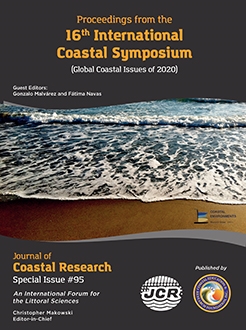Belova, N.G.; Novikova, A.V.; Günther, F., and Shabanova, N.N., 2020. Spatiotemporal variability of coastal retreat rates at Western Yamal Peninsula, Russia, based on remotely sensed data. In: Malvárez, G. and Navas, F. (eds.), Global Coastal Issues of 2020. Journal of Coastal Research, Special Issue No. 95, pp. 367–371. Coconut Creek (Florida), ISSN 0749-0208.
The work aims at estimating coastal retreat at Western Yamal from 1972 to 2016, when significant climate change occurred in the Arctic. One fourth of the Kara Sea coasts are collapsing cliffs composed of permafrost, i.e. thermoabrasional coasts. Although these coasts are bounded by sea ice for most of the year, they retreat with rates comparable to those of temperate latitudes, but only during the short ice-free period. Permafrost cliffs are not only eroded by waves; they also get destroyed by melting of the ground ice bounding the sediments (thermo-denudation). Arctic coasts are sensitive to climate change, as rising summer air temperatures lead to deeper thawing of frozen sediments, and longer ice-free periods extend the time of the wave impact on the coast. At Western Yamal, in the area of Kharasavey gas condensate field, the average long-term coastal retreat rate is 1.3 m/yr (1972-2016) for 5.9 km of the coastline, reaching mean annual rates of 3 m/yr in some areas. The greatest retreat rates are typical for coastal segments composed of permafrost with high ice content. Based on the analysis of multitemporal aerial and space images, the coastal retreat rates for four time periods between 1972 and 2016 were estimated. The retreat rates were brought into context with data on sediment composition and type (grain size, ice content, presence of massive ice), reconstructed evolution of hydrometeorological parameters and the history of economic development of Kharasavey area. Unlike other Kara Sea sites of coastal dynamics' monitoring, the strongest coastal retreat rates at Kharasavey were observed earlier in 1977-1988, when the hydrometeorological stress was low, implying vulnerability of the coasts to significant anthropogenic impact at the beginning of the gas field development.





